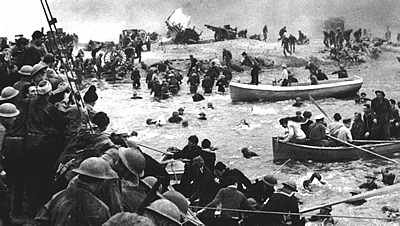On arrival in the beach area we saw the longest queue that we had ever seen in our lives. It seemed to stretch for miles, and was about six deep. Beyond one end of the queue was the casino and, thinking this would at least offer temporary shelter, we made our way there. We were soon relieved of our money in a card school. We then joined the queue. Some men told us that they had been waiting for four days. We were still unaware that this was an evacuation back to Britain. Most men seemed to think that we would be taken down the French coast to regroup and to re-enter the war . Air raids became more frequent and we had to dash for the sand dunes to escape the dive-bombers. The Germans concentrated their efforts on trying to destroy the mole from which groups of men were being taken off into all sorts of craft. It was June 1st, and the weather was perfect. Had there been gales or rough seas then the B.E.F. would have been lost, and the course of the war irretrievably altered. Eventually, after about 30 hours, we arrived at the front of the queue. The embarkation was controlled by a naval officer armed only with a walking stick. He ordered us to unload our rifles as he didn’t want any indiscriminate firing at aircraft overhead. The boat we boarded was called “The Gracie Fields”. It was not to get very far. Just as we were leaving the harbour we were dive-bombed and I found myself in the water. The ship sank very quickly – fortunately it was not a long swim to shore, but I had to get rid of my boots whilst managing to hang on to my rifle and steel helmet. Many were killed and injured.


No allowance was given for those unfortunate enough to be sunk whilst leaving, so it was back to the queue. It was not long, however, before I was near the front again, and I was delighted to meet some men from my own unit. This time we boarded the “Royal Daffodil” – a pleasure steamer based in Margate.
We sailed across the Channel without incident and arrived at Margate pier at about 6 p.m. We were a motley looking band with remnants of uniform, arms and headgear. We had many wounded, and these were transferred to ambulances. The rest of us were marched through the streets to the railway station. As I had no boots it was quite painful, although I had managed to keep my socks. It was a most eerie experience, as the inhabitants of Margate lined the streets about ten deep. They did not cheer or ‘boo’ – in fact we marched in absolute silence broken only by women softly weeping. The citizens of Margate seemed to be bewildered, and looked at us in disbelief. I suppose they were apprehensive as to what might happen next.
